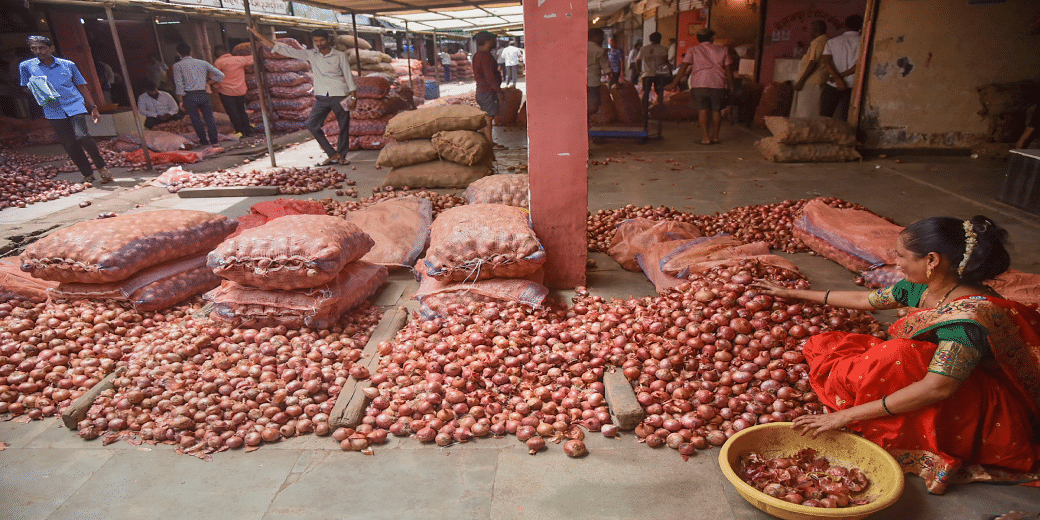Onion scare: price might not drop despite export curbs, say traders
Onion retail prices could rule firm at the high current levels, traders from the onion growing states have said, according to a report by The Economic Times.

Though the government has slapped a 40% export duty to arrest surging onion prices by discouraging exports and directing the stocks towards Indian kitchens, retail prices could rule firm at the high current levels, traders from the onion growing states have said, according to a report by The Economic Times. While the export curbs will certainly turn some of the crop towards the domestic markets, the Centre’s decision to purchase 2 lakh tonnes of onions at more than Rs 24/kg will itself keep onion prices at elevated levels, the traders remarked.
The export curb was announced on August 19. Traders’ bodies pointed out that since the announcement, prices have not declined anywhere.
Starting on 22 August, government agencies such as National Agricultural Cooperative Marketing Federation of India (Nafed) and National Cooperative Consumers’ Federation of India (NCCF) began procuring onions at Rs 24.10/kg in Maharashtra, the onion capital of the country.
“There has been no major change or decline in onion prices anywhere in the state since the export duty came into effect. The demand for onions is still strong everywhere. Now that Nafed has started buying onions at Rs 24/kg, farmers would like to hold onions expecting to get higher rates,” Nandkumar Shikre, chairman, Onion Traders Association, Ahmednagar, told the newspaper. While onion traders continued to oppose the export duty, a section of the onion grower associations said that the government must announce a floor price to enforce the export tariff. Earlier in the week Horticulture Produce Exporters Association (HPEA) dispatched a letter to the government urging it to announce a floor price. The absenc of a floor price could lead to unfair advantage to certain stakeholders and ports. They said that the floor price was required to ensure fair play.
“It is necessary to determine a floor price for calculating the export duty on onions across different land and sea ports. We fear that there may be a disparity in the floor prices being considered for the calculation of export duty on onions across different ports,” read the letter written by Ajit Shah, president of HPEA.
Protests against the export tariff continued in Maharashtra. Onion traders in the onion-producing region Nashik closed the wholesale market to protest against the decision.
The protests have also taken a political turn with onion farmers urging the people to vote against the BJP in the general elections.
“Onion farmers had been incurring losses for the entire last year due to subdued prices. Many of them haven’t yet received the subsidy amount that the government had announced to compensate for their losses,” said Jayadatta Holkar, director of Mumbai APMC.
The government is apprehensive that spiralling onion prices will further fuel the retail inflation that has already registered a growth of 7.44% score in July – a sharp rise from 4.81% in June – riding the high veggie prices. The RBI’s tolerance ceiling is only 6%. It was also found that vegetable prices contributed as many as 200 basis points to the July score.
To tame prices of rice and wheat, the government earlier applied export curbs on rice and wheat too.
Non-basmati rice exports came under a sudden ban on July 20. The government banned wheat exports in May 2022.
Download Money9 App for the latest updates on Personal Finance.
Related
- सरकार ने GST दरों में कमी के बाद पैकेजिंग नियमों को आसान बनाया
- GST दर सुधार पर परिषद की बैठक शुरू, तेदेपा का समर्थन, विपक्षी दलों ने राजस्व संरक्षण की मांग की
- एससीओ शिखर सम्मेलन में विकास बैंक की स्थापना को मंजूरी: चीनी विदेश मंत्री
- फिच रेटिंग्स ने भारत की साख को स्थिर परिदृश्य के साथ ‘बीबीबी’ पर रखा बरकरार
- कृषि, ग्रामीण श्रमिकों के लिए खुदरा मुद्रास्फीति जुलाई में घटकर 0.77 प्रतिशत एवं 1.01 प्रतिशत
- मंत्रिसमूह ने केंद्र के दो GST स्लैब के प्रस्ताव को स्वीकार किया

